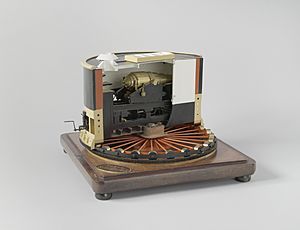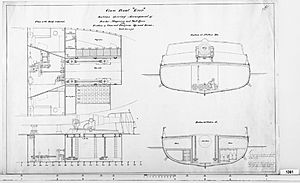RML 9-inch Armstrong Gun facts for kids
Quick facts for kids RML 9-inch Armstrong Gun |
|
|---|---|

Big model of gun turret on HNLMS Prins Hendrik,
showing RML 9-inch Armstrong Gun. |
|
| Type | Naval gun Coast defence gun |
| Place of origin | United Kingdom |
| Service history | |
| In service | 1867 |
| Used by |
|
| Production history | |
| Manufacturer | Elswick Ordnance Company |
| Specifications | |
| Mass | 12,300 kg |
| Length | 3.962 m |
|
|
|
| Calibre | 9-inch (229 mm) |
| Muzzle velocity | 0 feet per second (0 m/s) |
The RML 9-inch Armstrong Gun was a powerful cannon used on ships and for defending coasts. It was a "rifled muzzle loading" gun. This means it had grooves inside its barrel to make the cannonball spin, and it was loaded from the front. Many navies, especially the Dutch and Spanish, used these guns. It's important not to mix it up with a different British gun, the RML 9-inch 12-ton gun.
Contents
How These Guns Came About
Early Cannon Designs
For a long time, the United Kingdom used "smooth bore" guns. These guns had smooth barrels and fired round cannonballs. In the 1850s, they tested new "rifled breechloading" guns from other countries. These guns had grooves (rifling) inside and were loaded from the back (breech). However, the British government thought these new guns weren't much better for ships. So, they mostly stuck with their older smooth bore guns.
The Armstrong Gun Story
A clever inventor named William Armstrong, 1st Baron Armstrong created his own rifled breechloading gun. In 1859, he had a very successful test of his 18-pounder gun. Because of this, Armstrong got a new, important job as an engineer for rifled weapons.
His guns were made at the Royal Works in Woolwich and at a new company he helped start, the Elswick Ordnance Company. This new company was created to keep Armstrong's government work separate from his private business.
Armstrong's breechloading guns for the navy came in different sizes. Smaller ones worked very well after some changes. Even the larger 110-pounder guns did well in a battle in 1863.
However, by 1864, Armstrong's breechloaders faced a challenge. Newer "Rifled Muzzle Loaders" (RMLs), which were loaded from the front, proved to be better. The way Armstrong's breechloaders were rifled was not as good, and they cost more to make. A bigger problem was that the breechloading part couldn't handle the huge force needed to fire heavy cannonballs fast enough to break through enemy ship armor. Armstrong eventually pulled his breechloaders from tests that focused on armor piercing.
The Woolwich Gun
After this, the British Royal Navy went back to using rifled guns that loaded from the muzzle (front). These became known as Woolwich guns. Armstrong had improved the Woolwich factory, but he left his government job in 1863. The Woolwich factory then started making RML guns. They used Armstrong's way of making the gun barrel.
In 1865, Woolwich introduced new RML guns in 7, 8, and 9-inch sizes. These guns used a new rifling system called the Woolwich system, so they were called Woolwich guns.
The Armstrong RML for Export
While the Royal Navy made its own guns at Woolwich, Armstrong's company, Elswick Ordnance Company, kept making big guns, but mostly for other countries. One of these was a 9-inch RML gun. The Dutch Navy and others called it a 23 cm Armstrong gun. This meant it was made by Armstrong's company at Elswick. The British didn't call it an "Armstrong gun" without adding "Muzzle Loading" because for them, "Armstrong gun" usually meant his older breechloading type.
Gun Features
The 23 cm Armstrong RML gun was similar in size and barrel width (caliber) to the 9-inch Woolwich gun.
How It Was Made
A key difference between the Armstrong gun and the Woolwich guns was how they were reinforced. Armstrong's method involved making a steel barrel and then wrapping it with strong wrought iron coils. These coils helped the gun withstand the huge force of the explosion when it fired. The part of the gun closest to the explosion needed the most reinforcement.
The Armstrong gun used more, smaller coils, which made it more expensive to build. You can see these coils as bumps along the gun's barrel in pictures. Look at the photo of the 23 cm Armstrong RML on HNLMS Ever. The Woolwich guns, especially later models, had fewer coils, making them look smoother.
Different Models
The first four 9-inch Armstrong guns used by the Dutch Navy were a bit different. Their steel barrels were "open" at the back and were closed by a separate piece. Later Dutch models had steel barrels made from a single, solid piece.
Who Used These Guns
The HNLMS Prins Hendrik der Nederlanden was the first important armored ship for the Dutch Navy. It received the first four of these 9-inch Armstrong guns. Many records show this ship had "Armstrong guns," and some even say they were "made in Newcastle," confirming they were the RML 9-inch Armstrong Gun.
Four smaller ironclad ships and ten monitor ships also got two 9-inch Armstrong guns each, placed in a single gun tower. Additionally, 14 gunboats of the Ever class class each received one 9-inch Armstrong gun. The first two of these gunboats were built by the Armstrong Whitworth company itself.
In Spain, the ironclad ship Méndez Núñez was fitted with four 9-inch Armstrong guns. The central battery ironclad Zaragoza also had four. The Sagunto got eight of these guns, as did the broadside ironclad Vitoria.
Ammunition
Dutch Ammunition Types
The Dutch Navy used three main types of pointed grenades (cannonballs) with their 9-inch Armstrong guns:
- A regular iron grenade, about 68 cm long and weighing 105 kg.
- A hardened grenade, 52 cm long and weighing 112 kg.
- A steel grenade, 51 cm long and weighing 109 kg.
They also had a heavy "pointed bullet" (called puntkogel in Dutch) that was 46 cm long and weighed 113 kg. Even though it was called a "bullet," it was shaped like a cylinder. Finally, there were three kinds of shrapnel shot, each weighing about 68.50 kg. Shrapnel shot would break apart in the air, scattering many smaller pieces.



